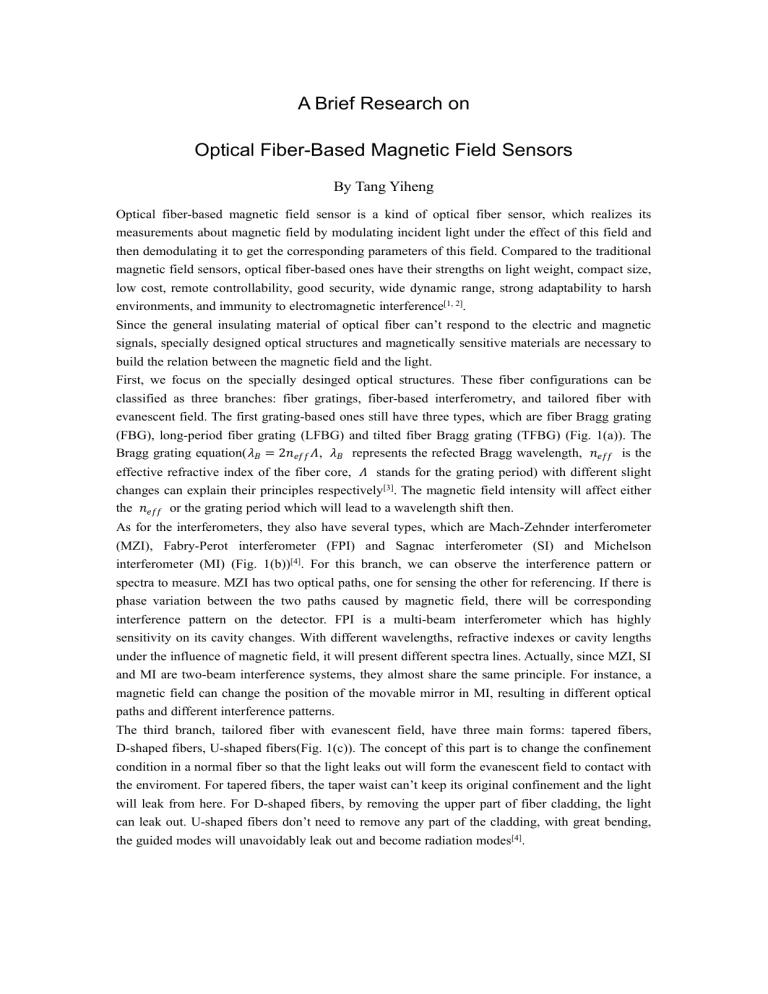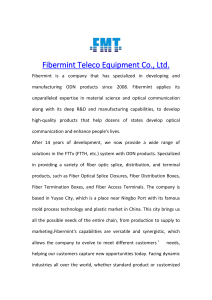
A Brief Research on Optical Fiber-Based Magnetic Field Sensors By Tang Yiheng Optical fiber-based magnetic field sensor is a kind of optical fiber sensor, which realizes its measurements about magnetic field by modulating incident light under the effect of this field and then demodulating it to get the corresponding parameters of this field. Compared to the traditional magnetic field sensors, optical fiber-based ones have their strengths on light weight, compact size, low cost, remote controllability, good security, wide dynamic range, strong adaptability to harsh environments, and immunity to electromagnetic interference[1, 2]. Since the general insulating material of optical fiber can’t respond to the electric and magnetic signals, specially designed optical structures and magnetically sensitive materials are necessary to build the relation between the magnetic field and the light. First, we focus on the specially desinged optical structures. These fiber configurations can be classified as three branches: fiber gratings, fiber-based interferometry, and tailored fiber with evanescent field. The first grating-based ones still have three types, which are fiber Bragg grating (FBG), long-period fiber grating (LFBG) and tilted fiber Bragg grating (TFBG) (Fig. 1(a)). The Bragg grating equation(�� = 2���� �, �� represents the refected Bragg wavelength, ���� is the effective refractive index of the fiber core, � stands for the grating period) with different slight changes can explain their principles respectively[3]. The magnetic field intensity will affect either the ���� or the grating period which will lead to a wavelength shift then. As for the interferometers, they also have several types, which are Mach-Zehnder interferometer (MZI), Fabry-Perot interferometer (FPI) and Sagnac interferometer (SI) and Michelson interferometer (MI) (Fig. 1(b))[4]. For this branch, we can observe the interference pattern or spectra to measure. MZI has two optical paths, one for sensing the other for referencing. If there is phase variation between the two paths caused by magnetic field, there will be corresponding interference pattern on the detector. FPI is a multi-beam interferometer which has highly sensitivity on its cavity changes. With different wavelengths, refractive indexes or cavity lengths under the influence of magnetic field, it will present different spectra lines. Actually, since MZI, SI and MI are two-beam interference systems, they almost share the same principle. For instance, a magnetic field can change the position of the movable mirror in MI, resulting in different optical paths and different interference patterns. The third branch, tailored fiber with evanescent field, have three main forms: tapered fibers, D-shaped fibers, U-shaped fibers(Fig. 1(c)). The concept of this part is to change the confinement condition in a normal fiber so that the light leaks out will form the evanescent field to contact with the enviroment. For tapered fibers, the taper waist can’t keep its original confinement and the light will leak from here. For D-shaped fibers, by removing the upper part of fiber cladding, the light can leak out. U-shaped fibers don’t need to remove any part of the cladding, with great bending, the guided modes will unavoidably leak out and become radiation modes[4]. Figure 1. (a) the structures of three kinds of bragg gratings (b) the structures of four types of interferometers (c) the structures of three forms of fiber that will produce evanescent field[2] Magnetically sensitive materials are used to convert the change of magnetic field (intesity and direction) into the change of other physical parameters like refractive index that can be detected by an optical fiber. These materials can also be divided into three groups: magnetic fluid materials, magnetic-strictive materials, and magneto-optical materials. For magnetic fluids (MFs), they have optical abilities such as introducing the change of refractive index, birefringence and Faraday effect when there is a magnetic field which can make the magnetic particles in the material to form chains. Magneto-optical materials take advantage of magneto-striction effect which is a feature of ferromagnets. Different magnitudes of a magnetic field will lead to different lengths of a ferromagnet which can affect the shape of some optical structure. The third category is magneto-optical materials that use the magneto-optical Faraday effect, which is also the most often used ones in fact, rotating the polarization plane of a linearly polarized light during its propagation. The rotation angle (is given by � = � � ��� 0 = ��� , where L is travelling distance in the material, B is the magnetic flux density along the direction of propagation, V is a special constant that strongly relies on the media we choose, environmental temperature and wavelength of incident light[1]) can be realize by doping rare-earth ions into glasses[5]. Garnet-crystals have been greatly researched these years. Obviously, magnetically sensitive materials need appropriate optical structure and vice versa, otherwise the sensors can’t operate. Except for the magnetic field sensor, the whole system can be applied as current sensors, geomagnetic monitoring, and quasi-distributed magnetic sensors. Let’s take current sensors for an example. The reason why we use this kind of sensor is to monitor the working status of electric power systems safely, reliably and sensitivly. Based on the Faraday magneto-optical effect, the sensor determines the current magnitude by the change of current caused by the magnetic field[2]. It is apt to measure great current in trasnmission cable if with protection on insulating. Besides, we can choose semiconductor laser diodes instead of He-Ne lasers instead to be the light source since they are lighter, less sensitive to vibration, less needed of high starting voltage. The first magneto-optical optical fiber current sensor came into being in 1980. There have been recent researches on minimizing the influence of temperature, improvement of stability and sensitivity and mitigating residual linear birefringence. In order to meet higher criteria and more demands, optical fiber-based magnetic field sensors still have a lot of aspects to optimize its performance. First, when it comes to manufacturing, the device packaging needs to be solved, not mention to the stability of the whole system. Since this system contains a lot of elements such as laser, prism, and polarizer, a little displacement of one element is likely to introduce great deviation of measurement. The best solution is to integrate all the parts of the whole optical path to fix relative position among elements. Second, low sensitivity and anti-disturbance issues must be overcome which limit its precision and measuring range to some extent[2]. The inevitable influence brought by temperature must be dealt with. Proper choice and design on structure and material can help a lot. Imperfect fabrication process of optical fiber must be considered as well. In addition, researches on multi-functional and multi-materials fiber can shed light on its broader prospects on geology exploration, biomedical detection, and aerospace engineering maybe even on national defense[4]. Reference [1] PENG J, JIA S, BIAN J, et al. Recent progress on electromagnetic field measurement based on optical sensors [J]. Sensors, 2019, 19(13): 2860. [2] ZHANG J, WANG C, CHEN Y, et al. Fiber structures and material science in optical fiber magnetic field sensors [J]. Frontiers of Optoelectronics, 2022, 15(1): 34. [3] OTHONOS A. Fiber bragg gratings [J]. Review of scientific instruments, 1997, 68(12): 4309-41. [4] ALBERTO N, DOMINGUES M F, MARQUES C, et al. Optical fiber magnetic field sensors based on magnetic fluid: A review [J]. Sensors, 2018, 18(12): 4325. [5] SUN L, JIANG S, ZUEGEL J, et al. Effective Verdet constant in a terbium-doped-core phosphate fiber [J]. Optics letters, 2009, 34(11): 1699-701.





